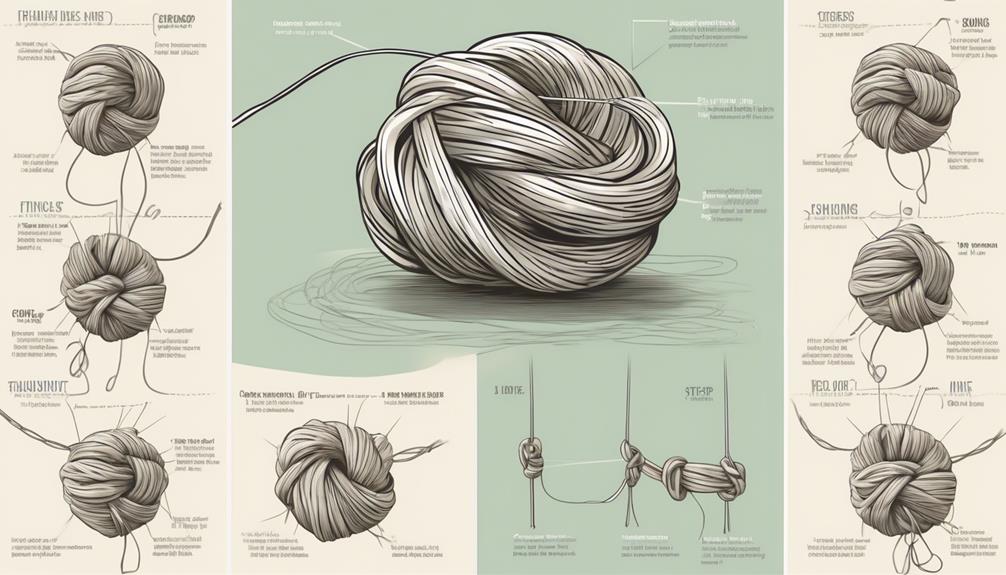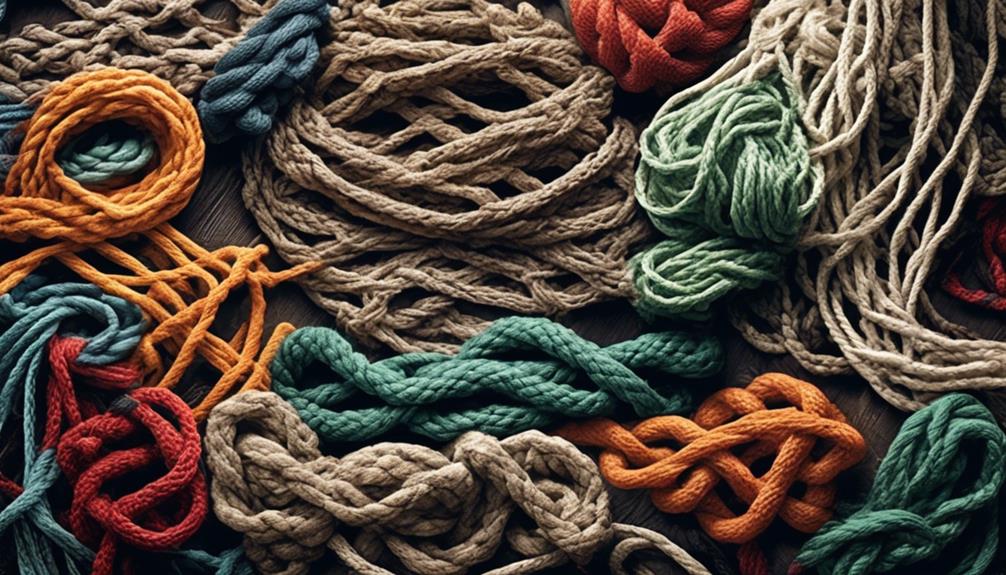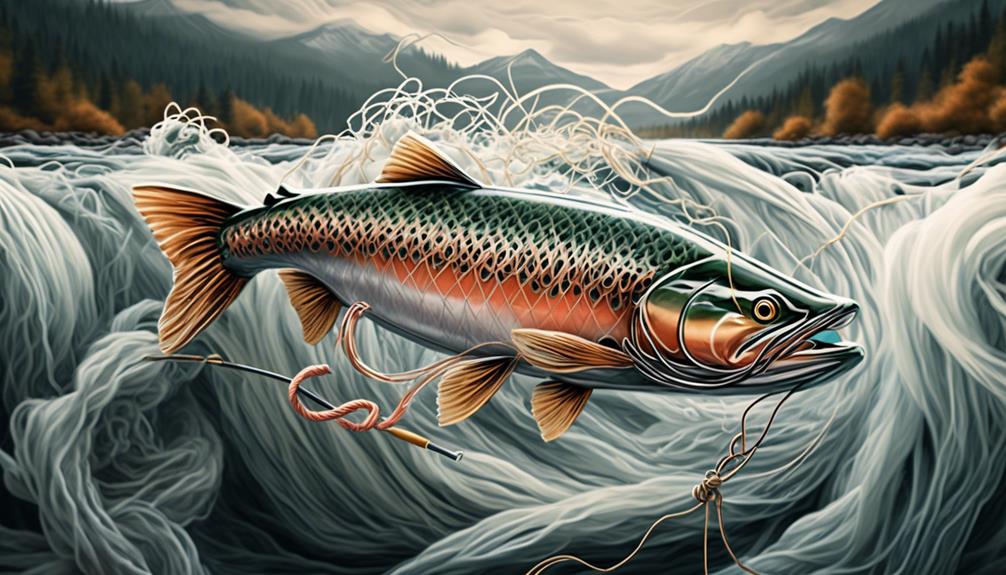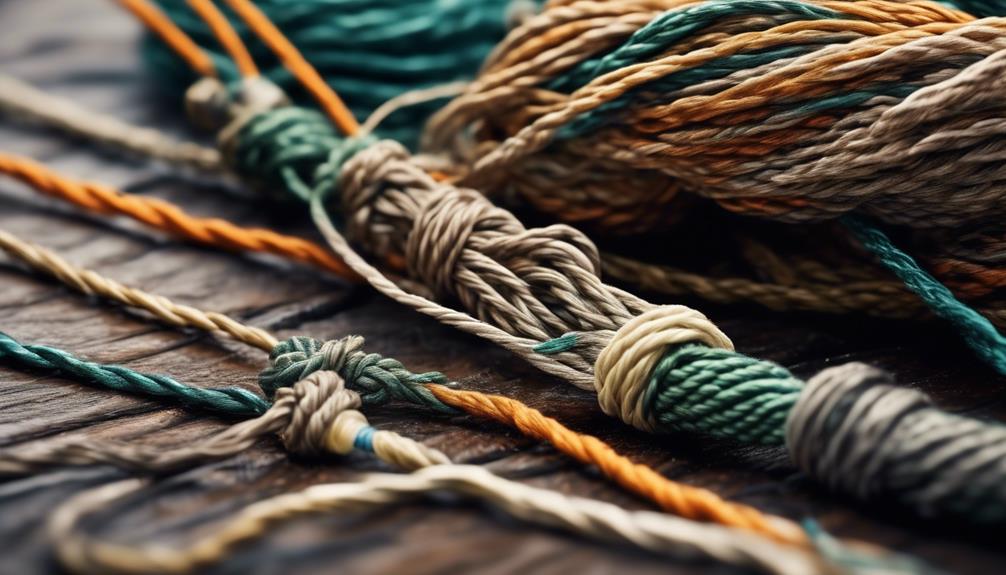Fishing is like a puzzle, and mastering the art of tying the right knot is like finding the missing piece. You've probably heard about the Improved Clinch Knot and the Palomar Knot, but what about the Uni Knot, the Double Uni Knot, or the Surgeon's Knot?
As a novice angler, knowing a variety of knots can greatly enhance your fishing experience. So, let's unravel the top 14 fishing knots that every beginner should have in their arsenal.
Improved Clinch Knot
If you want to secure your fishing line with a reliable and easy-to-tie knot, the Improved Clinch Knot is a great choice for novice anglers. This knot is widely used and recommended due to its simplicity and effectiveness. Here's a step-by-step tutorial to help you master this essential fishing knot:
Advantages of the Improved Clinch Knot include its strength and reliability. It's a versatile knot that works well with different types of fishing lines, making it a go-to option for most anglers. Additionally, it's relatively easy to tie once you get the hang of it, which is beneficial, especially for beginners. The knot's ability to maintain a high percentage of the line's original strength is another significant advantage.
However, as with any knot, there are also some disadvantages to consider. One potential issue with the Improved Clinch Knot is that it can be challenging to tie correctly at first, leading to potential slippage if not secured properly. It may also be less effective with larger diameter lines, so it's essential to assess its suitability based on the specific fishing conditions and equipment being used.
To tie the Improved Clinch Knot, follow these simple steps:
First, thread the line through the eye of the hook and double back parallel to the standing line.
Then, make five to seven wraps around the line.
After that, thread the tag end through the loop near the eye of the hook.
Finally, moisten the line and pull the tag end to tighten the knot.
Trim any excess line, and you're ready to start fishing.
Palomar Knot
The Palomar Knot is a highly reliable and simple knot that's favored by many anglers for its strength and ease of tying. It's especially beneficial for novice anglers due to its simplicity and effectiveness in securing the fishing line. Here are some key benefits and techniques of the Palomar Knot:
- Strength and Reliability: The Palomar Knot is known for its exceptional strength, making it suitable for various fishing conditions and types of fish. Its double-line design distributes the force across the line evenly, ensuring reliable performance when battling with hard-fighting fish.
- Ease of Tying: One of the primary advantages of the Palomar Knot is its simplicity. With just a few steps, you can quickly and easily tie this knot, even in challenging weather conditions or low-light situations. This makes it an ideal choice for novice anglers who may still be mastering their knot-tying skills.
- Versatility: The Palomar Knot is versatile and can be used with different types of fishing lines, including monofilament, fluorocarbon, and braided lines. Its adaptability across various lines makes it a go-to knot for many anglers.
When tying the Palomar Knot, there are some common mistakes and troubleshooting tips to be aware of:
- Common Mistakes: One common mistake when tying the Palomar Knot isn't ensuring that the loops are fully parallel and properly aligned before cinching down the knot. This can weaken the knot and lead to potential failures.
- Troubleshooting: If you find that the Palomar Knot is slipping or failing, ensuring that the knot is thoroughly moistened before tightening can help reduce friction and improve its overall strength and reliability.
Mastering the Palomar Knot and understanding its benefits and potential pitfalls will undoubtedly enhance your fishing experience.
Uni Knot
Mastering the Uni Knot is a fundamental skill for any angler looking to enhance their knot-tying repertoire. The Uni knot is renowned for its strength and versatility, making it a go-to choice for various fishing applications.
One of the most compelling features of the Uni knot is its impressive strength. Whether you're targeting small panfish or battling with larger game fish, the Uni knot provides reliable knot strength, giving you the confidence to tackle a wide range of fishing scenarios. Its ability to maintain a significant amount of its original line strength makes it an ideal choice for securing hooks, swivels, and lures.
The Uni knot's applications are diverse, making it an essential knot to have in your angling arsenal. This knot is highly effective for connecting terminal tackle such as hooks, swivels, and snaps. Its versatility also extends to joining lines of different materials and diameters, making it a valuable knot for creating leader connections.
Whether you're freshwater fishing for bass or trout, or heading offshore in pursuit of tuna or marlin, the Uni knot's adaptability makes it a reliable option for various fishing environments and target species.
Double Uni Knot
To enhance your knot-tying repertoire, consider learning the Double Uni Knot, a versatile and reliable knot for connecting lines of different materials and diameters. This knot is highly regarded for its strength and can be used in various fishing scenarios.
Here's why you should add the Double Uni Knot to your skill set:
- Double Uni Knot Strength: The Double Uni Knot is known for its exceptional strength, making it a popular choice among anglers. When tied correctly, this knot retains a significant amount of the line's original strength, allowing you to confidently tackle larger and stronger fish without worrying about your line failing at the knot.
- Double Uni Knot Applications: This knot is incredibly versatile and has a wide range of applications. It's particularly useful for tying lines of different diameters together, such as joining a heavier leader to a lighter mainline. Additionally, the Double Uni Knot is an excellent choice for connecting braided line to monofilament or fluorocarbon, providing a smooth and strong connection that won't fail when under pressure.
Learning the Double Uni Knot will undoubtedly expand your fishing capabilities, giving you the confidence to pursue a wider variety of fish in diverse fishing environments. With its strength and adaptability, this knot is a valuable addition to any angler's skill set.
Surgeon's Knot
You can quickly and securely join two lines together using the Surgeon's Knot, making it a convenient and reliable option for anglers of all skill levels. This knot is particularly useful when you need to connect lines of different diameters or materials. It's a simple knot that retains a significant amount of the lines' original breaking strength when tied correctly, making it a popular choice among anglers.
To tie the Surgeon's Knot, start by overlapping the ends of the two lines you want to join. Then, take one end and make a simple loop by bringing it over and under the other line. Next, wrap the end around both lines and through the loop you just created three or four times. Moisten the knot with some saliva or water to reduce heat from friction when tightening. Finally, hold the tag end and standing line, then pull them in opposite directions to close the knot. Trim the tag ends, and you have a strong, reliable connection between your fishing lines.
This knot is especially effective for monofilament and fluorocarbon lines. It's a great addition to your repertoire of tying techniques, as it can be tied quickly and provides a secure bond. Whether you're a beginner or a seasoned angler, mastering the Surgeon's Knot will enhance your fishing experience, giving you the confidence that your lines are securely joined.
Blood Knot
The Blood Knot, also known as the Barrel Knot, is a versatile and reliable knot used by anglers to join two lines of similar diameter with a strong and streamlined connection. This knot is especially useful when you need to connect two sections of monofilament or fluorocarbon line, maintaining much of the original line strength. When tied correctly, the Blood Knot is smooth and slim, allowing it to pass through rod guides with minimal resistance, making it ideal for leaders and tippets.
Here are some key points about the Blood Knot:
- Blood Knot Variations:
- Improved Blood Knot: This variation adds an extra tuck for added security, making it even stronger than the standard Blood Knot.
- Double Blood Knot: Used for connecting two lines of different diameters, this variation is particularly useful when joining a leader to the main line.
- Benefits of Using the Blood Knot in Different Fishing Scenarios:
- Fly Fishing: The Blood Knot is commonly used in fly fishing to join the leader and tippet, providing a smooth and strong connection that won't spook wary trout.
- Saltwater Fishing: When targeting saltwater species, the Blood Knot is invaluable for creating strong connections between the main line and leader, crucial for landing powerful fish.
- Freshwater Fishing: Whether you're targeting bass, trout, or panfish, the Blood Knot ensures a reliable connection between different sections of line, crucial for successful angling.
Mastering the Blood Knot and its variations will greatly enhance your ability to handle diverse fishing situations, giving you the confidence that your tackle can withstand the challenges of angling.
Albright Knot
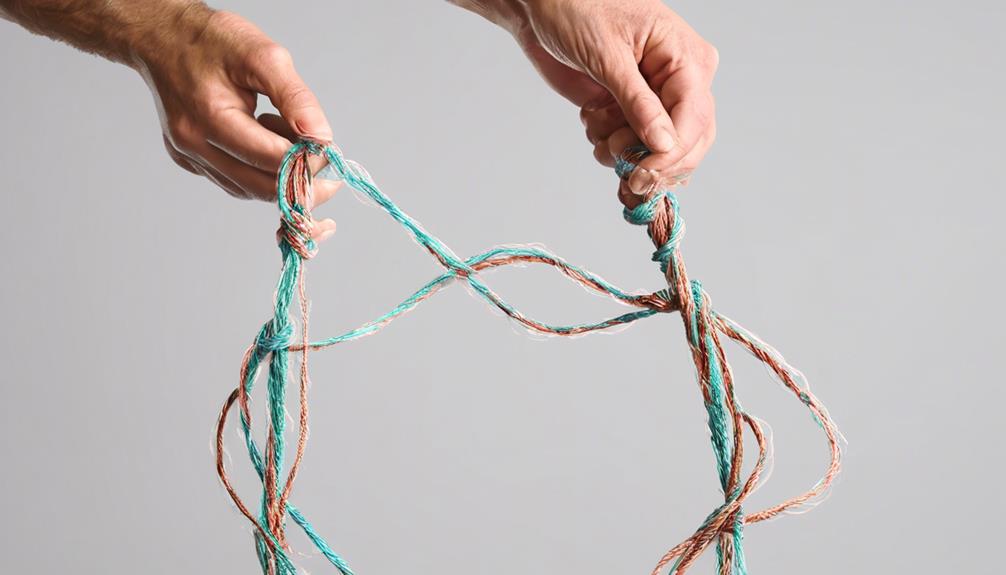
Having mastered the Blood Knot and its variations, anglers seeking a reliable knot for connecting lines of differing diameters will benefit from learning the Albright Knot. This knot is particularly useful for joining a heavier leader to a lighter main line, making it an essential skill for saltwater anglers targeting larger fish species.
The Albright Knot is renowned for its knot strength and is trusted by many anglers for its ability to withstand the powerful runs and sudden bursts of energy exhibited by saltwater game fish.
When tied correctly, the Albright Knot creates a smooth connection that easily passes through rod guides, allowing for seamless casting and retrieval. Its exceptional knot strength ensures that the line-to-line connection remains secure, even when battling aggressive saltwater predators. This knot's reliability is crucial in saltwater applications, where the forces exerted by fish such as tarpon, tuna, and billfish can test the limits of any connection.
To tie the Albright Knot, begin by doubling the leader line and overlapping it with the main line. Then, wrap the leader tag end and the doubled main line around each other at least ten times. After securing the wraps, thread the leader tag end back through the loop created near the main line's double. Finally, moisten the knot and pull both the main line and the leader tag end to cinch the wraps tight.
Mastering the Albright Knot is a valuable skill for any saltwater angler, as its knot strength and reliability make it an essential tool for connecting lines of differing diameters in challenging fishing conditions.
Rapala Knot
Named after the popular fishing lure company, the Rapala Knot is a reliable and straightforward connection to secure a hook or lure to the fishing line. It's a preferred knot among many anglers due to its strength and simplicity, making it an excellent choice for novice anglers learning the ropes of fishing knots.
When tying the Rapala Knot, it's crucial to understand its benefits and drawbacks:
- Benefits of the Rapala Knot
- Strength: The Rapala Knot retains a high percentage of the line's original strength, providing confidence when battling larger fish.
- Simplicity: Its simple and quick tying process makes it an ideal choice for beginners and experienced anglers alike.
- Smooth Movement: This knot allows the lure or hook to move freely, mimicking natural swimming action and increasing the chances of attracting fish.
- Drawbacks of the Rapala Knot
- Line Twist: One drawback of the Rapala Knot is that it can cause some line twist, especially when using certain types of lures or baits that spin in the water.
- Limited to Certain Lures: While the Rapala Knot works well for many lures and hooks, there are specific types of lures and rigs for which other knots may be more suitable.
When comparing the Rapala Knot to other popular fishing knots, it stands out for its simplicity and strength. While it may have some drawbacks, its reliability and ease of tying make it a valuable addition to any angler's repertoire.
Frequently Asked Questions
How Do I Choose the Right Knot for Different Types of Fishing Lines and Lures?
When choosing the right knot for different types of fishing lines and lures, consider the knot strengths and the specific fish species you're targeting. Some knots work better with certain lines or lures, and it's important to match them accordingly.
Also, if you're using heavy lures, opt for strong knots that can handle the weight.
Keep in mind that tying knots with gloves on can make it more challenging, so practice without gloves when possible.
Are There Any Special Techniques for Tying These Knots in Windy or Wet Conditions?
When tying fishing knots in challenging conditions like wet weather or windy situations, it's essential to adjust your technique. Keep your line and hands as dry as possible to maintain a strong grip.
Utilize secure knots that are easier to tie in adverse weather, like the improved clinch knot or the Palomar knot.
Practice tying these knots in calm conditions first to build confidence for when the weather gets tough.
Can These Knots Be Used for Saltwater Fishing as Well as Freshwater Fishing?
Absolutely! You'll have no problem using these knots for both saltwater and freshwater fishing. They're versatile and reliable.
When it comes to selecting knots for heavy-duty fishing lines, these top 14 knots have got you covered. Whether you're battling the waves at sea or casting your line in a calm lake, these knots will hold strong and keep your catch secure.
Are There Any Alternative Uses for These Knots, Such as Securing Camping Equipment or Tying Down Tarps?
Yes, the knots you've learned for fishing have alternative uses beyond the water. They're handy for securing camping equipment, like tying down a tent or securing a tarp.
These knots can also be valuable in survival situations, where you might need to secure shelter or create makeshift tools.
What Are the Common Mistakes or Pitfalls to Avoid When Tying These Knots for the First Time?
When tying these knots for the first time, common mistakes can include improper tensioning, which could lead to weaker knots. Properly lubricating the knot and ensuring it's tightened with the right tension is crucial to avoid slippage.
It's important to pay attention to detail and not rush the process. Take your time and practice until you can tie each knot confidently, ensuring they're secure for their intended use.
Conclusion
Now that you've learned these top 14 fishing knots, you're well on your way to becoming a skilled angler.
Remember to practice these knots before your next fishing trip, and soon enough, you'll be tying them with ease.
Don't be afraid to ask for help or watch instructional videos if you need a refresher.
With these knots in your arsenal, you'll be ready to tackle any fishing situation that comes your way.
Happy fishing!
